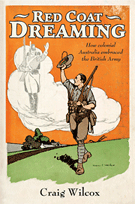
A black man wears a red coat as he welcomes ships into Sydney Harbour in the 1820s. Revellers at an anniversary ball raise their glasses to the Battle of Waterloo in 1829. In Western Australia in the 1850s, a young man 'too squeamish to be a doctor' waits impatiently for his commission as an ensign in the British Army. Ex-soldiers arriving in colonial Australia merged with other settlers on farms and in towns; in old age, despite their service to King and country, they must 'make do with a small allowance and growing affection'. In the 1880s crowds at the New South Wales Art Gallery gather to admire a grand history painting from the Anglo-Zulu War, The Defence of Rorke's Drift. Some are moved to tears by it. And in Australian suburbs in the 1970s, boys collected model soldiers, devoured magazines and stories about them, 'and came to love red coats as much as any Australian before them had done'. According to Craig Wilcox, they were all 'red coat dreaming'.
For too long now, argues Wilcox, have Australians failed to realise the importance of the British army in their history and culture. Australia's current obsession with Anzac (he calls it 'slouch hat worship') has elided this much longer military history, a history of pride, pomp and the glorious sight of those massed ranks of seductive, scarlet coats; and the fact that the British army was woven into the fabric of society. The book is triggered by material culture: the red coats, diaries, medals, portraits and history paintings held in museums and collections around Australia, as well as pubs and street names that are still part of everyday townscapes. Each chronologically arranged chapter is built around such artefacts, moving from their particular stories, painstakingly researched, into the wider histories of the period they illuminate. The book thus belongs to a new genre of material culture studies, so wonderfully exemplified by Philip Jones's Ochre and Rust, in which objects are deeply considered in the light of their historical contexts ('the fragment's tangible and intangible connections', as Wilcox describes it, p. xv). At their best, these are not merely histories illustrated with artefacts (I used to refer to this practice in historical archaeology as 'history with a bone thrown in'), but voyages into what Bernard Smith calls 'a more archaeological, more humanist view of our history'.[1]
The stories Wilcox presents are carefully unfolded and beautifully told, sometimes with great poignancy, at other times with an amused, ironic eye. He avoids the common trap of wanting to include every precious detail — he's too good a narrator for that. His writing is quite marvellous, for it is fluid, inviting and evocative. Clearly this book is a personal quest and a labour of love. Wilcox appears to have had it inside him for a long time, and he begins and ends with his own youthful fascination with the history of war and the British army via 'Airfix and antique armies' (p. xiii). It was therefore always going to be a largely celebratory account, a reverie about love, pride and commemoration. Except for the Battle of Waterloo, the negative stories of war and insurrection, including Australia's frontier wars, are dealt with very briefly, with businesslike briskness, if at all. Tensions and violence between soldiers and civilians tend to be presented humorously.
The concluding chapter moves into the more recent past, and from history into polemic. Wilcox wants us all to recognise the redcoats, alongside those usurping Anzacs, as part of national heritage and identity. It doesn't seem to occur to him that not all Australians identify with khaki and slouch hats, or indeed with anything military, or that the further 'militarisation of Australian history' might not be such a good thing.[2]
The recruitment of the English-Aboriginal word 'dreaming' is rather startling too. Wilcox is aware of this, but nevertheless claims parity between an ancient, ever-present Aboriginal past and spirituality, and his tales of 'the cooler martial imagination of their conquerors' (p. xv). Yet, apart from Bungaree, the leader of the Sydney Aborigines in the 1810s and 1820s, there are very few Aboriginal people in this book. Even Bungaree's story is rather speculative, and it assumes his wearing of the red coat must signal the same 'red coat dreaming' as that of the white characters in the book. Bungaree wore it for the 'authority and prestige the real thing commanded' (p. 123). In other words, it is about mimicry, and rather pathetic mimicry at that. Yet who is the warrior here — Macquarie, who never actually led soldiers into battle, or Bungaree, widely admired veteran of many great contests? There is a tendency to use the artefacts to back up the author's deeply felt convictions. In my own experience artefacts don't do this — they tend to overthrow things we thought we knew. They have radical potential. It is more likely that Bungaree and the many other jacket-wearing warriors had their own interpretations of red coats, and their own reasons for wearing them.
Nevertheless, Red Coat Dreaming combines excellent research with historical imagination and wonderful writing to evoke a lost world. It is a fine social history of the British army in Australia and a very welcome addition to the study of material culture.
Grace Karskens is an associate professor in the School of History and Philosophy at the University of New South Wales.
1 Bernard Smith, 'History and the collector — 1974', in Bernard Smith, The Death of the Artist as Hero: Essays in History and Culture, Oxford University Press, Melbourne, 95–100.
2 M Lake, H Reynolds et al., What's Wrong with Anzac? The Militarisation of Australian History, UNSW Press, Sydney, 2010.
